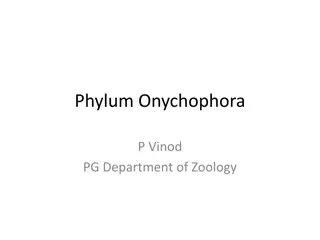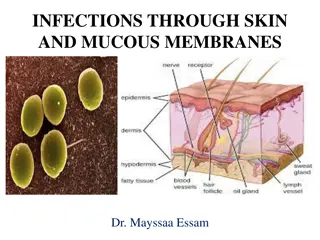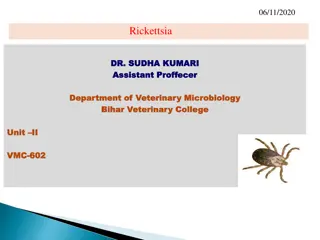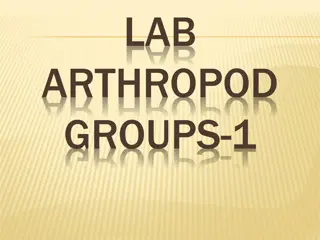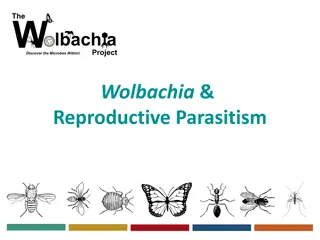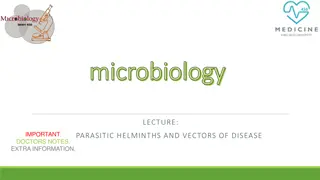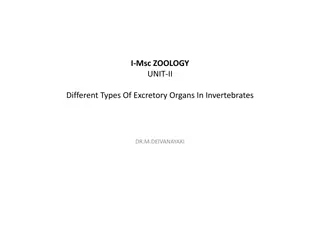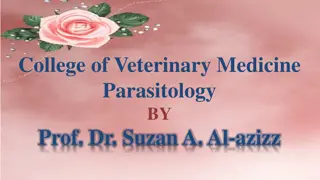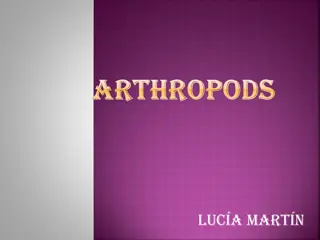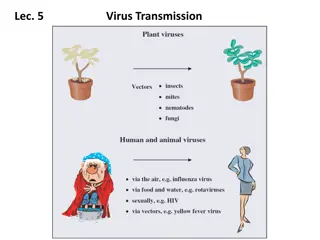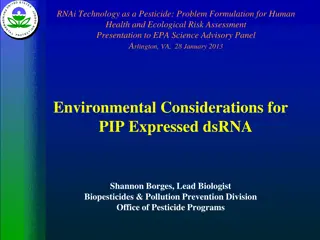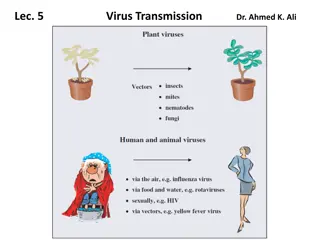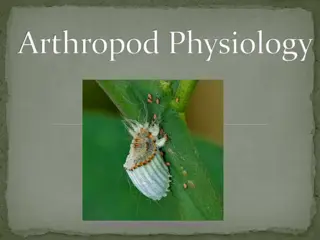Phylogenetic Status of Peripatus: Exploring its Systematic Position
Peripatus, known as claw bearers, exhibits characteristics of both annelids and arthropods, making it an intriguing species in the study of evolutionary biology. Considered as an intermediate link between these two phyla, Peripatus raises questions about its classification and evolutionary history.
0 views • 10 slides
Understanding Infections through Skin and Mucous Membranes
Infections can be transmitted through skin and mucous membranes via direct or indirect human contact, as well as from non-human sources. The infective agents include viruses, bacteria, fungi, and arthropods. Factors like high population density, poor hygiene, and host behavior play crucial roles in
4 views • 26 slides
Understanding Exoskeletons: Structure, Function, and Diversity
Exoskeletons are rigid coverings that support and protect the bodies of various animals, serving vital roles in structure, defense, and movement. They vary in composition, such as chitin in arthropods and bone in vertebrates like turtles. This comprehensive overview explores the significance, types,
0 views • 4 slides
Lab 2: DNA Extraction Techniques for Arthropods and Wolbachia
In this lab activity, students will learn how to isolate genomic DNA from arthropods and Wolbachia bacteria. The goal is to transition from fieldwork to molecular biology, utilizing DNA as a diagnostic tool. The activity involves extracting total genomic DNA from identified species and includes pre-
0 views • 11 slides
Understanding Rickettsia: Pathogenesis, Clinical Manifestations, and Diagnosis
Rickettsia, a genus of Gram-negative bacteria transmitted by arthropods, is responsible for diseases like Rocky Mountain spotted fever. It causes symptoms such as high fever, rash, and severe headache. Laboratory diagnosis involves serology and isolation from experimental animals. Learn more about R
1 views • 9 slides
Overview of Arthropods: Classification and Characteristics
Arthropods are a diverse group of invertebrates characterized by segmented bodies, appendages, and chitinous exoskeletons. They belong to the Phylum Arthropoda and are classified into four important classes: Myriapoda, Crustacea, Arachnida, and Insecta. This article explores the unique features of e
0 views • 18 slides
Understanding Akabane Disease: Causes, Symptoms, and Prevention
Akabane disease, also known as Enzootic Bovine Arthrogryposis and Hydranencephaly, is a viral illness transmitted by arthropods that primarily affects calves, lambs, and kids. The disease can lead to congenital abnormalities such as joint immobility and absence of the cerebral hemisphere. It is caus
2 views • 19 slides
Understanding Parasitology: A Comprehensive Overview
Parasitology is the study of parasites, their hosts, and the interactions between them. This field explores the different aspects of parasitism, including the relationships between parasites and hosts, the classification of major parasite groups like protozoa, helminths, and arthropods, and terms cr
0 views • 16 slides
Understanding Wolbachia: Reproductive Parasitism and Control Strategies
Wolbachia is a fascinating bacterium known for inducing reproductive parasitism in arthropods, affecting their offspring's sex ratios and survival. This article explores the impact of Wolbachia on different species, genetic crosses, cytoplasmic incompatibility, and vector control strategies such as
0 views • 5 slides
Understanding Parasitic Helminths and Disease Vectors in Microbiology
Explore the world of parasitic helminths and disease vectors in microbiology. Learn about the classification of parasites, the life cycle of Ascaris lumbricoides, and the role of arthropods as agents and vectors of diseases in humans. Discover the characteristics of the three main groups of parasiti
0 views • 18 slides
Understanding Parasitic Helminths and Arthropod Vectors of Diseases by Dr. Mona Badr
This educational material delves into the classification, morphology, and life cycles of parasitic helminths, focusing on the roundworm Ascaris lumbricoides. It also explores the role of arthropods as agents and vectors of diseases in humans, providing insights into the location of helminthes in the
0 views • 28 slides
Overview of Different Excretory Organs in Invertebrates
In invertebrates, there are various types of excretory organs such as the contractile vacuole, nephridium, renal gland, coxal gland, and Malpighian tubule. These organs play crucial roles in osmotic regulation and nitrogen excretion. Different phyla exhibit diverse excretory structures like nephridi
0 views • 6 slides
Understanding Parasitology in Veterinary Medicine by Prof. Dr. Suzan A. Al-azizz
Parasitology is a vital study of parasites and their hosts, encompassing various disciplines like cell biology, bioinformatics, genetics, and ecology. This field emphasizes the binomial system of species naming pioneered by Linnaeus. The essence of human scientific naming is exemplified by Homo sapi
0 views • 16 slides
Fascinating World of Arthropods: From Insects to Arachnids
Arthropods, the largest and most successful group in the animal kingdom, encompass a wide range of organisms, including insects, arachnids, myriapods, and crustaceans. Insects, with their distinct body regions and exoskeleton, play crucial roles in ecosystems. Arachnids, such as scorpions and spider
0 views • 14 slides
Fascinating World of Arthropods: Incredible Adaptations and Ecological Dominance
Arthropods, joint-legged animals of the phylum Arthropoda, comprise over 80% of described animal species and exhibit remarkable adaptive diversities. They dominate various habitats, colonizing land, air, and water. Arthropods play significant ecological roles, with diverse feeding habits and efficie
0 views • 32 slides
Understanding Virus Transmission via Vectors
Viruses must be transmitted to new hosts for their survival. This transmission occurs through vectors like arthropods, which acquire and transmit viruses during feeding. The mechanism involves viruses attaching to the vectors' mouthparts or entering their circulatory system to reach salivary glands
0 views • 14 slides
Understanding Environmental Risks of RNAi Technology as a Pesticide
This presentation discusses the environmental considerations and risk assessments associated with RNAi technology as a pesticide, focusing on the unique challenges presented by dsRNA PIPs. Topics covered include ecological risk assessments, nontarget organism exposure, exposure assessments for PIP p
0 views • 13 slides
Arthropod Biomimicry: Designing Protective Body Armor for Post-Apocalyptic Survival
In a scenario where groups are preparing for the end of the world, the concept of arthropod biomimicry is employed to design protective body armor for humans inspired by the exoskeletons of arthropods. The armor is required to ensure safety, attractiveness, and mimic other arthropod adaptations apar
0 views • 4 slides
Understanding Biological Hazards in the Workplace: A Comprehensive Overview
This chapter delves into the realm of biological hazards in occupational settings, shedding light on the risks posed by microorganisms, arthropods, allergens, toxins, and more. It highlights the diverse range of biological agents that can lead to infections, allergies, toxic reactions, and even seri
0 views • 45 slides
Fascinating World of Arthropods: Diversity and Characteristics
Arthropods, the largest phylum in the animal kingdom, exhibit a wide array of characteristics and play crucial roles in various ecosystems. From crustaceans to insects, these invertebrates showcase segmented bodies, jointed appendages, and diverse respiratory systems. Explore the world of arthropods
0 views • 12 slides
Understanding Virus Transmission via Vectors in Hosts
Viruses must be propagated and transmitted to new hosts for survival. They can be spread via vectors like arthropods, which acquire and transmit viruses during feeding. This transmission can occur quickly through the vector's mouthparts or more slowly via circulation in the vector's body. Plant viru
0 views • 14 slides
Arboviruses: A Comprehensive Overview of Arthropod-Borne Viruses
Arboviruses, transmitted by bloodsucking arthropods, are a diverse group of RNA viruses with varied classifications like Togaviridae, Flaviviridae, Bunyaviridae, Reoviridae, and Rhabdoviridae. In India, Dengue, Chikungunya, and Japanese Encephalitis are prevalent arboviruses. Togaviridae, including
0 views • 70 slides
Overview of Arthropod Physiology and Morphology
Explore the fascinating world of arthropods, focusing on their physiology and morphology. Discover the unique features of insects like their open circulatory system, complete digestive system, and dorsal brain. Delve into the specialized structures of Hemipteran insects such as their modified beaks
0 views • 11 slides
